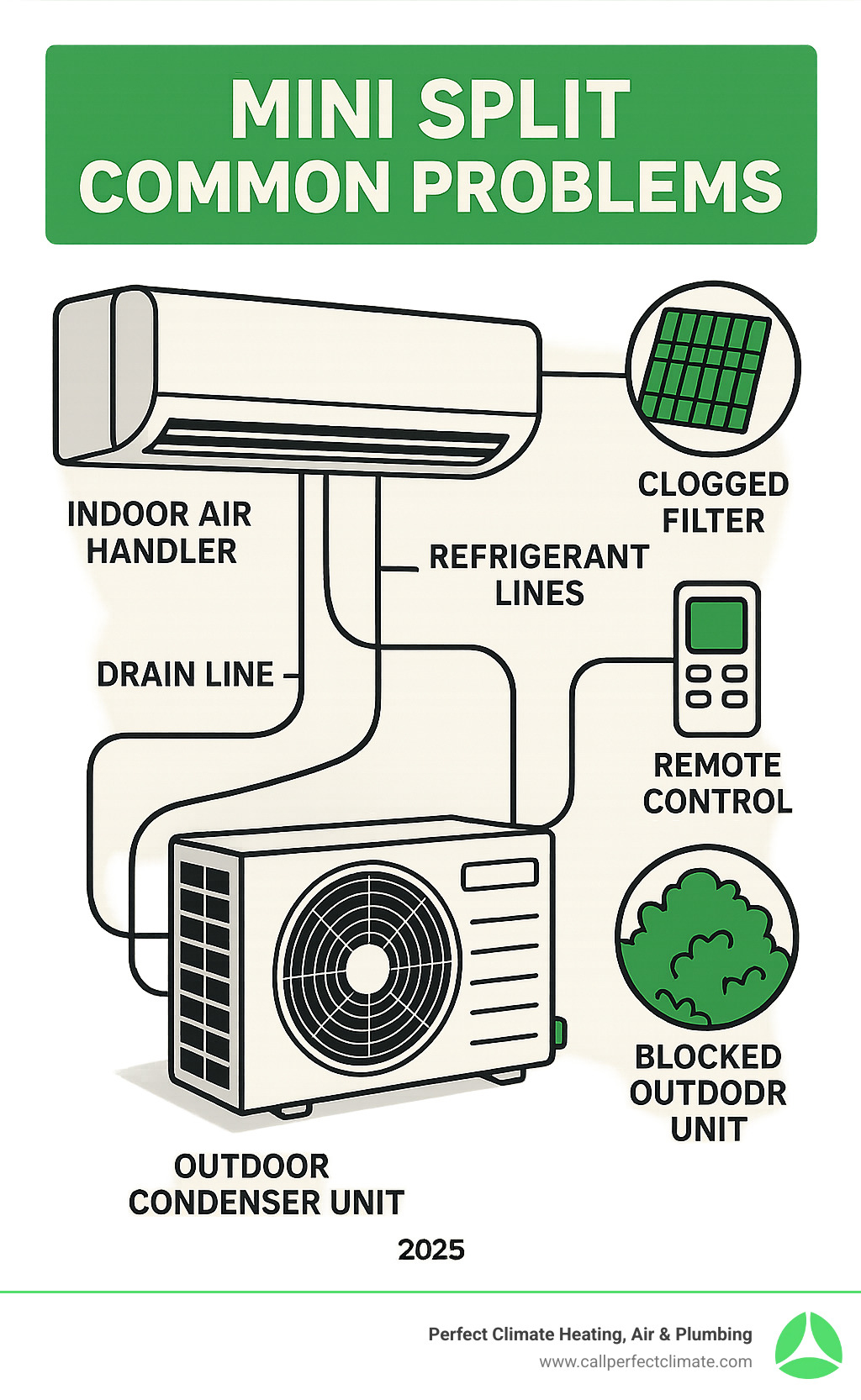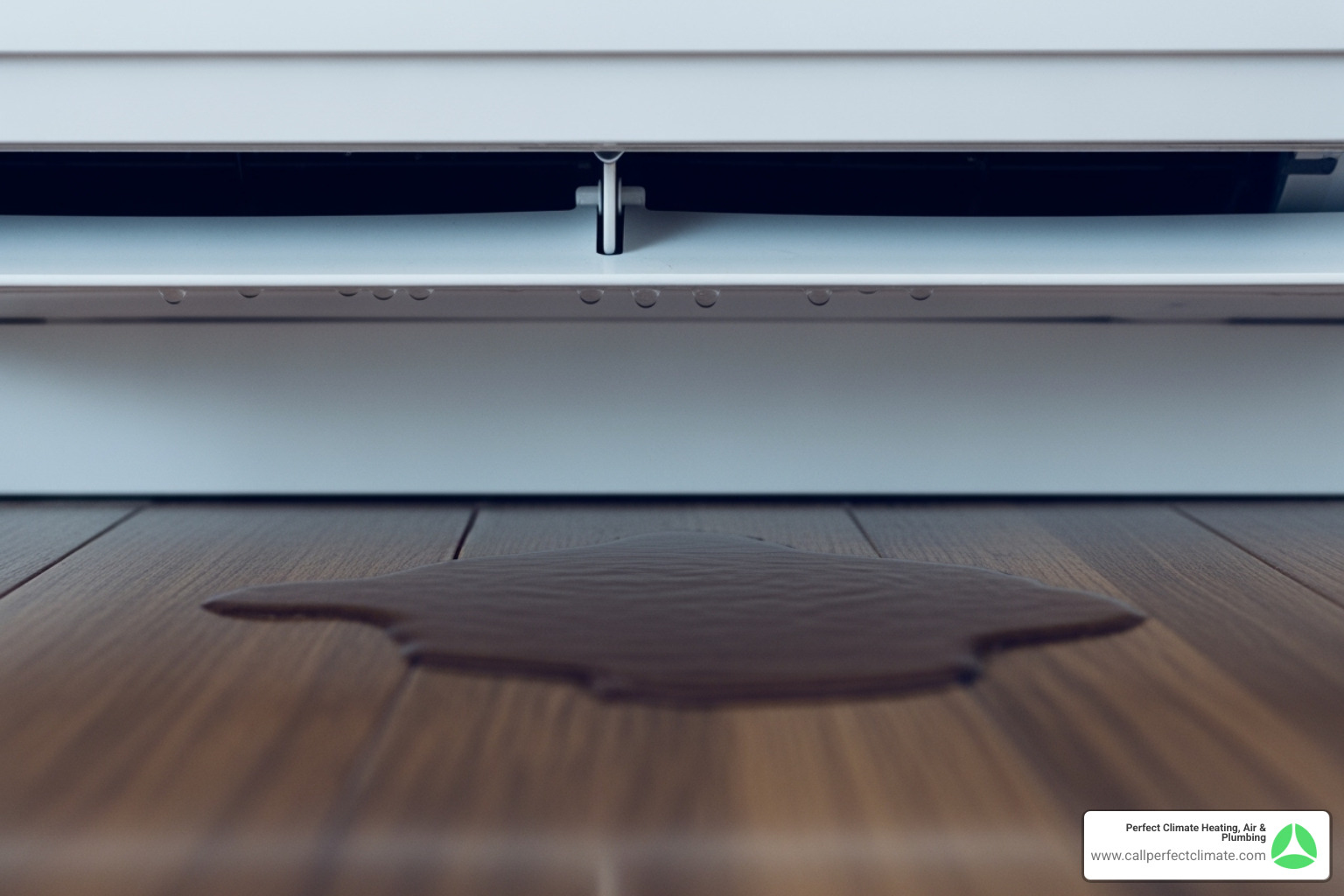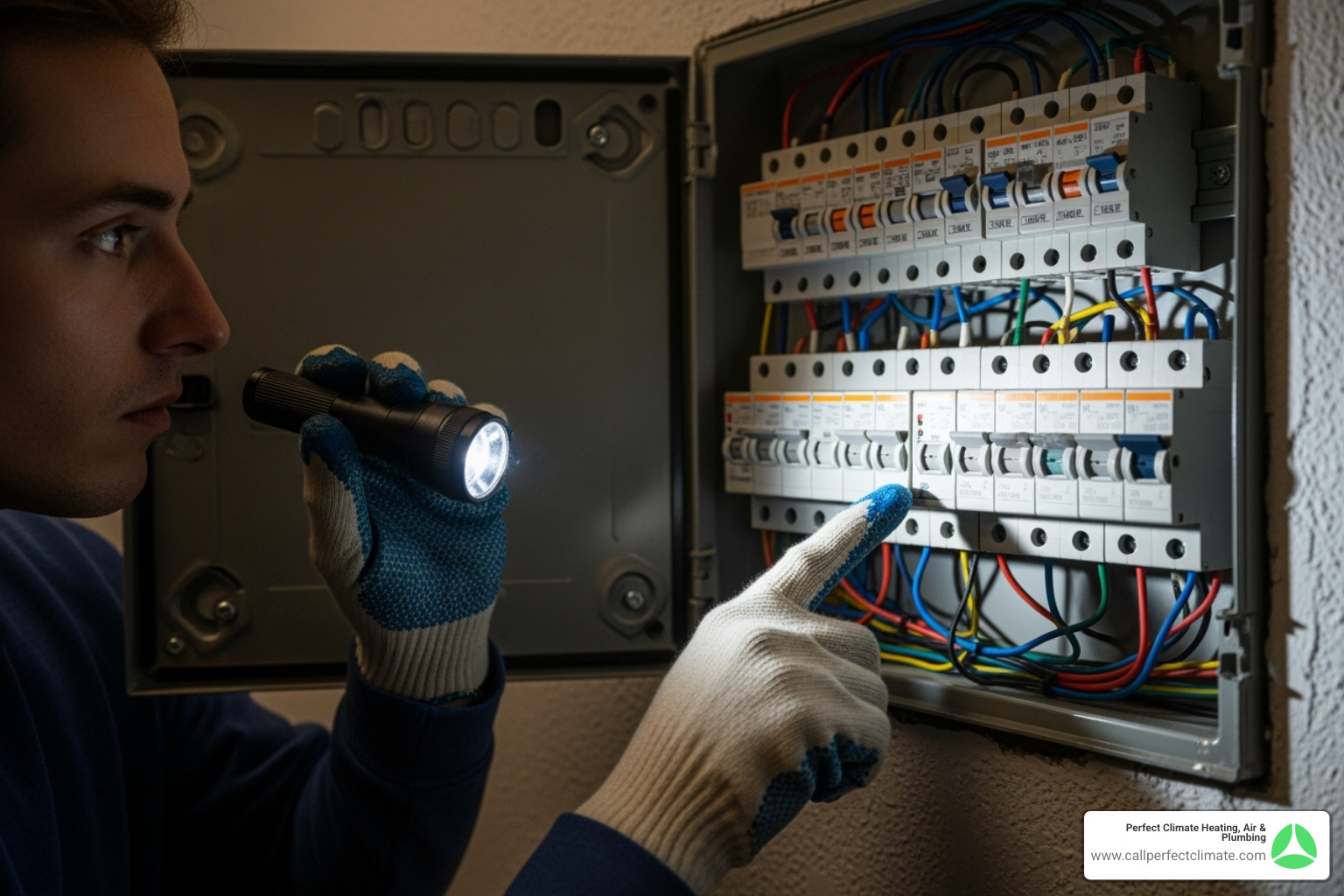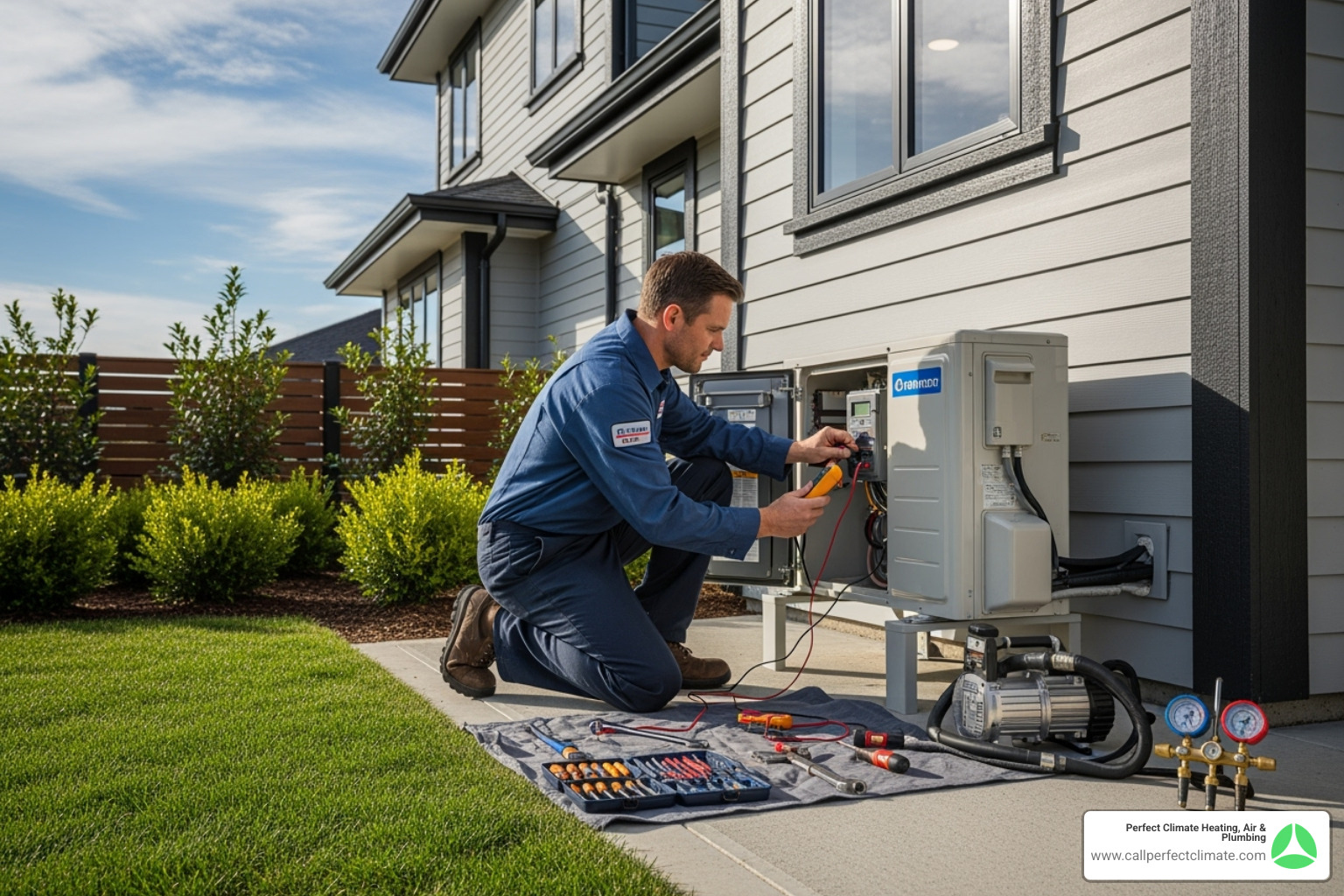Why Your Mini Split Isn’t Working (And How to Fix It)
Mini split common problems can be a source of frustration. While reliable, these efficient ductless systems can develop issues affecting your comfort and energy bills.
The most common mini split problems include:
- No cooling or heating – Often caused by dirty filters, refrigerant leaks, or incorrect settings
- Water leaking – Usually from clogged drain lines or frozen coils
- Strange noises – Popping, gurgling, or rattling sounds indicating component issues
- Unusual smells – Musty, vinegar, or fishy odors pointing to mold, refrigerant leaks, or electrical problems
- System won’t turn on – Typically due to dead remote batteries, tripped breakers, or electrical faults
- Poor air quality – From dirty filters or mold growth in the system
Mini splits provide energy-efficient heating and cooling without ductwork. When working properly, they operate quietly and maintain consistent temperatures. However, problems can develop from normal wear, lack of maintenance, or environmental factors.
The good news is that many mini split issues have simple solutions. Some you can fix yourself, while others require professional expertise. Understanding the difference can save you time, money, and unnecessary service calls.
Performance Problems: When Your Mini Split Isn’t Cooling or Heating
When your mini split isn’t delivering cool air in summer or warmth in winter, it’s often due to a few common culprits. We’ll explore why your system might be underperforming and how to diagnose the issue.
Inadequate Cooling or Heating
The most common reasons a mini split fails to cool or heat effectively involve airflow and refrigerant.
A dirty air filter is a primary cause, as it severely restricts airflow. This reduces performance, increases energy use, and can lead to other problems like frozen coils. Regularly cleaning or replacing your air filters is a crucial step in maintaining your mini split’s efficiency.
A clogged evaporator coil can also hinder performance. Dust and debris on the coils create an insulating layer that prevents proper heat transfer, reducing cooling or heating capacity.
Incorrect remote settings are also surprisingly common. Ensure the remote is in the correct mode (e.g., cool, not fan-only) and the temperature is set appropriately. Setting the thermostat too low can overwork the system without reaching a stable temperature.
Finally, a blocked outdoor unit severely impacts performance. The condenser needs clear airflow to function. If the unit is surrounded by leaves, snow, or debris, it can’t work efficiently. Ensure there’s at least two feet of clearance around the outdoor unit. For more insights, explore our guide on Ductless HVAC Efficiency.
For further troubleshooting, our Mini Split Heat Pump Troubleshooting guide offers more detailed steps.
Signs of Frozen Coils and Low Refrigerant
Ice on your mini split’s coils is a clear sign of trouble, usually pointing to restricted airflow or a refrigerant problem. You might see ice on the indoor unit’s coils or on the refrigerant lines.
A dirty air filter is a prime suspect. Restricted airflow makes the coils too cold, freezing airborne moisture onto them. Low refrigerant is another major cause. If your system lacks enough refrigerant, it can’t absorb heat effectively, leading to abnormally low pressure and temperature within the coils, causing them to freeze.
Other signs of frozen coils or low refrigerant include:
- Reduced airflow from the indoor unit.
- Longer run times as the system struggles to reach the set temperature.
- Warm air in cooling mode or cool air in heating mode.
- Hissing or bubbling sounds, which can indicate a refrigerant leak.
- A sweet or vinegar-like smell, another sign of a refrigerant leak.
Refrigerant isn’t consumed during operation, so low levels indicate a leak. If you see ice or suspect a leak, shut off the system immediately and contact a professional to avoid damaging the compressor, a very expensive component.
Sensory Clues: Decoding Strange Noises, Smells, and Leaks
Your mini split communicates problems through sounds, smells, and leaks. These mini split common problems are your system’s way of asking for help. Learning to decode these clues can help you catch issues early.
Why Is My Mini Split Leaking Water?
A puddle under your mini split is alarming, but water leaks are a common and often fixable issue.
The most frequent cause is a clogged drain line. As your system cools, it creates condensation that should flow outside through a drain line. If this line is blocked by mold, dust, or debris, water backs up into the drain pan. When the pan overflows, water drips from your indoor unit, potentially causing water damage and mold and mildew growth.
A cracked drain pan can also cause leaks, though this is less common. If you spot a leak, turn off your system immediately to prevent further damage. While you can try to clear the line yourself, professional cleaning ensures the problem is solved correctly. For more help, see our Ductless AC Issues and Solutions.
What Do Unusual Noises Mean?
Mini splits are typically quiet, so strange noises are a clear sign something is wrong.
- Popping or clicking sounds are usually harmless, caused by plastic housing expanding and contracting with temperature changes.
- Gurgling or swooshing noises often occur during the normal defrost mode. However, if frequent, they might signal low refrigerant or faulty sensors.
- Rattling or banging sounds are more serious. Rattling suggests a loose part, like a fan blade or debris. Banging can point to major compressor or internal component issues.
- Buzzing or humming that is loud and persistent can indicate electrical trouble, a struggling fan motor, or compressor problems. A gentle hum is normal, but anything louder requires professional attention.
Identifying Unpleasant Odors
Your nose can be a great tool for diagnosing mini split problems.
- A musty or “dirty sock” smell indicates mold growth on the evaporator coil or in the drain pan. This can negatively affect your indoor air quality.
- A vinegar or sweet smell is a sign of a refrigerant leak. This chemical odor, combined with poor performance, means you should turn off the unit and call a professional immediately.
- A fishy or burning smell signals an electrical problem, such as overheating components or faulty wiring. This is a fire hazard. Turn off the system at the breaker and call for service right away.
Ignoring these smells won’t make them go away, and the underlying problems usually worsen over time.
Power and Control: Addressing Electrical and Thermostat Glitches
Sometimes the issue isn’t performance, but simply getting the unit to turn on. These mini split common problems often stem from simple electrical or remote control issues. The good news is that many have straightforward solutions.
My Mini Split Won’t Turn On: First Steps
If your mini split won’t turn on, don’t panic. Start with these common culprits.
- Dead remote batteries are a frequent cause. Fresh batteries can often solve the problem instantly.
- Next, check your circuit breaker panel. A breaker can trip from power surges. Look for the breaker for your HVAC system and reset it by switching it fully off, then back on.
- Also, check the outdoor unit power switch. This disconnect switch, usually in a small weatherproof box near the condenser, can be accidentally turned off. Ensure it’s in the “on” position.
- Finally, double-check your remote settings. The system might seem off if it’s in the wrong mode, like “fan only.” Verify you are in the correct mode (heat, cool, or auto) with an appropriate temperature setting.
Common Electrical Mini Split Problems
If basic troubleshooting fails, you may have a more complex electrical issue that requires a professional.
- Blown fuses or faulty wiring can interrupt power, causing intermittent operation or complete system failure.
- A malfunctioning compressor is a serious electrical problem that can cause a complete shutdown or repeated failed attempts to start.
- Frequent system cycling (short cycling) is hard on your system and wastes energy. It often points to faulty temperature sensors or control board malfunctions.
- Modern mini splits rely on circuit boards and sensors. When these electronic components malfunction, you may see erratic behavior or unresponsive controls.
- Power surges can damage sensitive electronic components.
For a deeper dive into these issues, see our guide on Mini Split Heat Pumps Common Problems. Electrical problems can be dangerous, so it’s always best to call a professional for diagnosis and repair.
Proactive Care: Preventing Common Mini Split Problems
The old saying “an ounce of prevention is worth a pound of cure” couldn’t be more true when it comes to mini split common problems. Proactive care will keep your system reliable for years and help you avoid unexpected breakdowns.
DIY Maintenance to Keep Your System Running Smoothly
You don’t need to be a tech wizard to keep your mini split happy. Some of the most effective maintenance tasks are surprisingly simple.
- Cleaning your air filters is the most important DIY task. During heavy use seasons, clean them monthly. Pop them out, rinse with warm water, let them air dry completely, and slide them back in. This improves efficiency and lowers energy bills.
- Keeping the outdoor unit clear is also crucial. Every few weeks, clear away leaves, grass clippings, and debris to ensure it has room to breathe and operate efficiently.
- Checking your drain line is as simple as a visual inspection. Occasionally look for obvious blockages or kinks to prevent water backup.
- Using your remote settings efficiently can prevent unnecessary wear. Use the “auto” mode for consistent comfort without overworking the system. Avoid extreme temperature settings.
For a deeper dive into keeping your ductless system in peak condition, our Guide to Ductless HVAC Maintenance covers everything you need to know.
When to Call a Professional for Mini Split Repair
While we love a good DIY spirit, some situations call for professional expertise. Knowing when to step back can save you from turning a manageable problem into an expensive disaster.
- Refrigerant leaks are not a DIY job. If you suspect a leak (sweet smell, ice buildup, poor cooling), call a pro. Refrigerant requires certified handling.
- Electrical problems, like faulty wiring or burning smells, are a safety hazard. Always call a professional for electrical issues.
- Major component failures, such as compressor or fan motor issues, require specialized knowledge and parts.
- Persistent noises or smells that don’t resolve with basic troubleshooting need an expert diagnosis.
- Frozen coils that return after cleaning the filter signal a deeper problem, like low refrigerant or sensor issues, that needs professional attention to prevent compressor damage.
Regular professional tune-ups can catch these issues before they become emergencies. Our Benefits of Ductless HVAC Tune Up in Mount Carmel page explains how preventive maintenance can save you money.
Repair or Replace? Making the Right Choice
This is the question that keeps homeowners up at night. The decision doesn’t have to be overwhelming if you know what factors to consider.
- System age: Most mini splits last 10-15 years. If your system is approaching this age and needs a major repair, replacement is often more cost-effective.
- Repair frequency: If you need frequent repairs, a new system is likely a smarter long-term investment.
- Repair costs: If a single repair costs nearly half the price of a new system, replacement is usually the better financial choice.
- Energy efficiency: Newer models are significantly more efficient and can lower your utility bills, helping a new system pay for itself over time. You can learn more about high-efficiency models at the ENERGY STAR website.
- Parts availability: It can be difficult to find parts for older, discontinued models, which may make replacement your only option.
We’ll walk you through these considerations honestly. Sometimes a repair is the right call, but when multiple factors point toward replacement, we’ll help you understand why a new system might be your best bet. Our Guide to Ductless HVAC Replacement can help you steer this decision with confidence.
Frequently Asked Questions about Mini Split Issues
When you’re dealing with a mini split that’s acting up, you’ll have questions. Here are answers to the most common ones we hear from homeowners.
How much does it cost to fix a mini split refrigerant leak?
Fixing a refrigerant leak is a multi-step process. A technician must locate the leak, perform the repair, and then recharge the system with the correct amount of refrigerant.
The cost varies depending on the leak’s location and the extent of the repair. Generally, you can expect the cost to be between $300 to $1,000. This covers the technician’s time, parts, and the refrigerant itself. Since refrigerant doesn’t get used up, low levels always mean there’s a leak that needs professional attention.
How often should a mini split be serviced?
Think of servicing your mini split like getting an oil change for your car. We recommend bi-annual tune-ups: one in the spring before the cooling season and another in the fall before the heating season. This schedule allows a technician to catch potential issues before they become emergencies.
During a tune-up, a technician will clean indoor and outdoor coils, check refrigerant levels, clear the condensate drain line, inspect electrical connections, and test system controls. Regular servicing is the best way to prevent expensive problems and ensure your system runs efficiently.
What are the most common mini split problems homeowners can fix themselves?
You can solve several mini split common problems on your own, saving you time and money on a service call.
- Cleaning or replacing air filters: A dirty filter is a top cause of poor performance. This should be done monthly during peak seasons.
- Replacing remote control batteries: If the unit is unresponsive, check the remote’s batteries first.
- Clearing the outdoor unit: Ensure the area around the outdoor condenser is free of leaves, grass, and other debris.
- Resetting the circuit breaker: If the unit loses power, check your electrical panel for a tripped breaker.
- Verifying thermostat settings: Make sure the unit is set to the correct mode (cool/heat) and temperature.
These simple troubleshooting steps can often restore your comfort without needing a professional.
Conclusion: Keep Your Home Comfortable with a Healthy Mini Split
Your mini split system works hard to keep your home comfortable, and it deserves regular care in return. Understanding mini split common problems empowers you to know when to perform a simple DIY fix and when it’s time to call a professional. This knowledge can save you both money and stress.
Proactive maintenance is your best friend for ensuring your mini split’s longevity. Simple tasks like monthly filter cleanings and keeping the outdoor unit clear are investments in your system’s health and your family’s comfort, preventing small issues from becoming major headaches.
Of course, some problems require professional expertise. Refrigerant leaks, electrical faults, and persistent strange odors are signals that it’s time to let an expert handle the issue safely and effectively.
At Perfect Climate Heating, Air & Plumbing, we’ve seen it all when it comes to mini split challenges. Whether you need routine maintenance, emergency repairs, or guidance on whether repair or replacement makes the most sense, we’re here to help. Our goal is keeping your home’s climate perfect, just like our name suggests.
Don’t let mini split troubles leave you sweating through summer or shivering through winter. With the right combination of homeowner knowledge and professional support, your ductless system can provide reliable, efficient comfort for years to come.
Ready to give your mini split the expert care it deserves? Contact Perfect Climate Heating, Air & Plumbing for expert mini split installation and service throughout Indiana. Let’s work together to keep your home comfortable, no matter what the weather brings.




